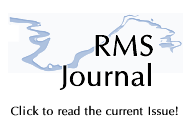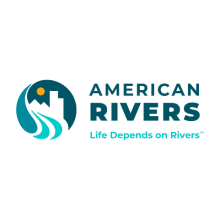- Home
- About
- Training & Events
- Resources
- For Members
2024 RMS Award WinnersThe River Management Society (RMS) congratulates winners of its 2024 River Management Awards, individuals whose achievements and leadership among river professionals inspire us. Ronald Stork, Linda Richmond and Travis Connot were recognized as winners of the Frank Church Wild and Scenic Rivers Award, Outstanding Contribution to River Management Award and River Manager of the Year Award, respectively. These honors, open to both members and non-members, represent the highest form of peer appreciation. Nominations are submitted by individuals from the river management community, and the selections are made by the RMS Awards Committee, led by the National Secretary. As we had no symposium this year, each award was presented in a separate venue as described below along with the amazing contributions of these river professionals. Learn more about our awards categories, and submit a nomination for 2025 award winners by Dec. 31, 2024. These will be presented at the April 2025 RMS Symposium in Ashland, Oregon. Celebrate past award winners on our RMS Awards page. River Manager of the Year: Travis Connot
This award recognizes contributions that are field-oriented with a focus on recent accomplishments. Travis Connot of the Niobrara National Scenic River in Valentine, Nebraska, is this year’s winner. The award was presented with the staffs of both Niobrara National Scenic River and Missouri National Recreation River in attendance by Park Superintendent Susan Cook. A heartfelt thank you and appreciation for the vision Travis has for the park's work along the river was given. Local media including print and television were in attendance and the TV clip was picked up by several other outlets. Travis Connot lives the park motto of “We take care for the river by helping our landowners care for their land.” His work is innovative and forward thinking as he strives to ensure this river’s resources are protected for future generations” stated Superintendent Cook. Travis has always been dedicated to this area, its resources, and working collaboratively with landowners and partnerships. Travis is the Natural Resources Program Manager/Biologist for Niobrara National Scenic River. His strong dedication and passion for water has driven him to making the Niobrara River sustainable for everyone a top priority. A little background of Niobrara National Scenic River. NIOB is a 76-mile stretch in north-central Nebraska, which most of it is privately owned. The Niobrara River is roughly 70% groundwater fed and 30% rain/snow runoff. The groundwater comes from the High Plains (Ogallala) Aquifer. There are over 200 waterfalls in the first half of the scenic river. NIOB is unique in that six different ecosystems converge here, creating a mix of flora and fauna, and some unique hybrids. Niobrara River is also known for its recreational opportunities, where tubing, canoeing, and kayaking is a fun summer adventure. Farming, ranching, and recreation are some of the bigger livelihoods in Valentine and the surrounding area which rely on these natural resources, especially the water. Working with partners and private landowners, Travis has built up the water quality and quantity program sampling efforts at NIOB from just seven sites to 20 sites. Water sampling begins in April and runs through October. With 20 sites being sampled, the water run is broken out into three days, scheduled the first Wednesday of each month. Water quality parameters sampled for each site consist of E. Coli, pH, Specific Conductivity, Dissolved Oxygen (DO), Water Temperature, Nitrates, Ammonia, Phosphorus, Alkalinity, Salinity, Turbidity, Air Temperature, and a daily blank and duplicate for E. Coli. Water quantity sampling consist of Stream Flow, Stream Stage, Gage Height, Recent Rainfall, and Runoff Evidence. By collecting this scientific data, Travis hopes to make better water management decisions with partners based on the reliable data. Management decisions, such as impairments or flows, will be easier to pinpoint the areas of concern by having 20 different sites. Ensuring good water quality and quantity for the people of the area and the for the future drives Travis’s passion. Creating a new proactive approach for Niobrara National Scenic River is what led Travis to apply for the United States Geological Survey-Natural Resources Preservation Program (USGS-NRPP) Grant. Travis wrote and received the USGS-NRPP grant, titled “Sustaining the Niobrara: Understanding Groundwater-Surface Water Interactions to Inform River Management” for $264,000 to monitor the groundwater to surface water interactions. This grant funding will be used for installing five groundwater monitoring wells along with pressure transducers to take daily water level readings. Well locations have been strategically selected while working with Ft. Niobrara-National Wildlife Refuge, Cherry County Commissioners, University of Nebraska at Lincoln, USGS, Natural Resource Districts, and private landowners. Temporary stream gages will also be installed to see the influx of groundwater to surface water correlation. The data collected will be published and shared with conservation partners and landowners. Travis hopes to expand upon this by applying for more funding to install multiple other dedicated monitoring wells throughout the 76-mile stretch. He also monitors daily rainfall and moisture content in snow for Nebraska Rainfall Assessment and Information Network (NeRAIN) in partnership with Nebraska Department of Natural Resources (NeDNR) Nebraska Natural Resource Districts (NRDs), and the Nebraska Environmental Trust (NET). This data is available for public access offering an interactive map and reports at NeRain - Home (nebraska.gov) He is also working with USGS, to do continuous water quality parameters and stream flow at the stream gage near Sparks, NE. Currently, there is a push for Federal Priority Stream gages (FPS), where USGS would like to add 50% more stream gages throughout the United States. Travis has been actively looking at locations that would strengthen the data he is collecting and improve upon water management decisions. To date, Travis has selected three potential stream gage sites that will play a big factor in continuous data collection for NIOB. The stream gage data is available to partners and the public to view at Water Resources of the United States—National Water Information System (NWIS) Mapper (usgs.gov) Rangeland is a big part of the surrounding area, and a well-managed range can provide many benefits. Travis works with the Natural Resource Conservation Service (NRCS) and is an active member of the Range Management Society, where they teach and host range judging to high school students. Travis helps host the area competition where 200 high school students attend and the state competition where 500+ high school students attend. Travis also helps the local Future Farmers of America (FFA) chapter with natural resource practicums. Practicums are created for critical thinking, bringing in all aspects of natural resources, wildlife, and farming/ranching. This critical thinking teaches cause and effect actions to students. Travis is also asked to be a judge at District FFA, where 75 students create presentations related to natural resources. Travis conducts threatened and endangered species studies within the Niobrara River corridor. He also conducts monthly wildlife studies along the watershed, where mammals, reptiles, and birds are all accounted for. Working with the Nebraska Game & Parks Commission information is shared to assist in wildlife management. This past year, Travis was asked to be a speaker for two different organizations: the Nebraska Water Leaders Academy and the National Association of Wetland Managers, sharing his knowledge of water around the Niobrara River and improvements towards conservation efforts. Travis’s passion for the water, dedication to the landowners and wildlife, and drive for accurate, reliable data for decision making with partners makes him the River Manager of the Year. Outstanding Contribution to River Management: Linda RichmondThis award recognizes a history of contributions to the field of river management. Linda Richmond of Bluff, Utah is the 2024 winner recognizing her long career as an outstanding advocate for professional river management, her communication skills, and her amazing body of work. Linda received the award at a small get together on May 5, 2024 at the Sand Island Ranger Station, the put in for the San Juan River. The event was planned and hosted by current river ranger, Rick Boretti. Guests included Linda's daughter and granddaughter, current and former supervisors, co-workers, and volunteers. In RMS tradition Linda knew nothing about the award until it was announced and placed in her hand by former RMS President, Dennis Willis. Linda worked from for close to 40 years in river management - an extraordinary length of time for a field operations employee, having adapted and enhanced the river unit operations on the San Juan River from the program's infancy to today. Linda contacted individuals from other river management programs to research ideas on how to solve common river management challenges. She was open to a wide range of ideas and implementation strategies Longevity in any career demands that you adapt to a wide variety of management personalities, goals, and communication styles. Linda was passionate about professional river management, effectively communicating with both management and employees working with her from other disciplines. In many cases, management might not realize what effect their decisions or actions might have on the river program. Linda was able to educate management on both problems and possible solutions to problems. Linda was involved in all aspects of the river management program including permitting, campsite maintenance and development, wildlife protection, invasive species control, and visitor safety. She provided management with creative concepts for how to deal with ever increasing public visitation. This included ideas to provide for a fair and understandable river permit system dealing with both commercial and private permitting, closure recommendations for the long-term benefit of wildlife and river habitat, interagency coordination, including with tribal entities, and how to keep operations running within the given budget. Linda developed and implemented campsite surveys to increase baseline knowledge. She worked with and scheduled river staff to work with all types of school groups and individual researchers assisting them in all aspects of their programs. Often, she coordinated with tribal groups to organize and provide access for interpretation of resources. A retired law enforcement colleague said that Linda assisted her in many aspects of law enforcement on the river including recognition of potential violators, development of new regulations, and physical river skills. Most importantly, Linda used education as to the background for the development of specific regulations to protect both the public and the environment. Through the years Linda coordinated meetings both on and off the river among agency management, diverse agencies, Glen Canyon NRA, Utah Division of Wildlife, Navajo Fish and Wildlife, Utah and New Mexico Fish research, Hopi and Navajo tribal entities and educational groups. Topics included wildlife management practices, coordination and practices for applicable law enforcement, enhancement of visitor safety, enhancement of the visitor experience, control and mitigation of invasive vegetation, as well as permit procedures and goals. Check in procedures at the San Juan River were most educational for visitors regarding their role in caring for rivers due to the attention Linda paid to the presentation of the material as well as the selection and training of volunteers who also presented this information. Due to her knowledge of how other river programs were run and what information visitors may or may not have been accustomed to hearing she was very good at giving the appropriate level of information for specific groups. Her professionalism and background in education was obvious whenever she was in contact with visitors. As she knew the progression of the program through so many years, she was able to explain to visitors the evolution and need for specific requirements to be met while on the river and the long-term benefits of these regulations. Linda was greatly respected and admired by the public and all the various agencies she worked with over the years. Frank Church Wild and Scenic Rivers Award: Ron Stork
This award recognizes contributions focused on the management, enhancement, or protection of designated Wild and Scenic Rivers. It recognizes a history of contributions with a broad geographic scope. Ronald “Ron” Stork of Friends of the River in Sacramento, California is the 2024 award winner. He was presented the award on April 26 at the Friends of the River annual River Awards Gala in San Francisco. The long-time, dedicated Senior Policy Advocate for Friends of the River (FOR), Ron has been working for Wild & Scenic Rivers (W&SRs) in California for more than 40 years. He is a national expert in California and federal W&SR legislation and regulation. He has a lifetime of achievement for Wild & Scenic Rivers in California. In the early 1980’s, as the director of the Merced Canyon Committee, Ron successfully guided the effort to obtain National Wild and Scenic River designation for the Merced River. The committee was formed to protect the natural and public resources of the Merced River Canyon- the gateway to Yosemite National Park. Made up of citizens of the Merced River Canyon and other local communities with about 600 members at the time of the hearing for designating the Kern and Merced Rivers as National Wild and Scenic Rivers. The bill supported was Senate Bill 275 which aimed to protect the entirety of the Merced River above Lake McClure Reservoir. Ron was able to garner further support with efforts from The National Park Service, the U.S. Forest Service, and the Bureau of Land Management- agencies who managed over 90% of the river corridor. He led the way to make a joint draft proposal via the Sierra National Forests Draft Land Management Plan (LMP). After much deliberation Senate Bill 275 was successfully passed. Prior to joining FOR, and together with FOR’s Steve Evans after joining FOR in 1987, Ron has experienced multiple campaigns to establish W&SR designations, the Merced, Kings, and Kern in November of 1987, the Lower Merced in 1992, South Fork of the Yuba in 1999, Cache Creek in 2005, Black Butte River in 2006. Friends of the River, Steve Evans, and Ron worked on W&SR advocacy for many years across many watersheds and legislative efforts, which resulted in passage of the Omnibus Public Land Management Act of 2009 (Public Law 111-11). The bill was a conglomeration of public land and water measures affecting more than half of the states in the union, as well as the Puerto Rico Commonwealth. For California, the Omnibus Act included designation as Wild and Scenic Rivers 105 miles of streams, as well as 750,000 acres of new Wilderness and Wilderness additions. Ron has also been instrumental in protecting California’s W&SRs. On behalf of FOR, he led the successful fight against the Auburn Dam, that would have destroyed the North Fork of the American River. He navigated through many conflicts of the California W&SR system with the California State Water Project and the Federal Central Valley Project. He remains active today in advocating for the protection of the McCloud River from the proposed Shasta Dam Raise. Ron has worked on a number of W&SR management plans, including serving on the Citizens Advisory Committees for the Lower American River Parkway Plan update and Lower American River Corridor Master Plan, and provided assistance to the BLM, Forest Service, and NPS for the Merced River wild & scenic river plans. Ron continues his W&SR work today at Friends of the River. In addition to his advocacy, he publishes regular updates on W&SR threats and opportunities. Ron is an insightful observer of history and has compiled detailed histories of past W&SR events. He maintains a comprehensive and constantly updated memo on the California W&SR system. He serves as an expert to many, on W&SR history, legislation, and strategy. His accumulated and present contributions to national and state Wild & Scenic Rivers over the last 40 years are far-reaching, and cannot be over-stated. Ron is a national expert in flood management, federal water resources development, hydropower reform, and Wild & Scenic Rivers. He joined Friends of the River as Associate Conservation Director in 1987 and became its Senior Policy Advocate in 1995. Ron was presented the prestigious River Conservationist of the Year award by Perception in 1996 for his work to stop the Auburn dam. In 2004, he received the California Urban Water Conservation Council’s Excellence Award for statewide and institutional innovations in water conservation. A note of gratitude for RMS Award plaquesDennis Willis, past RMS President, has overseen and paid for all aspects of fabrication of our lovely RMS awards for well over a decade. He works with the fabricator to create the awards, always improves the language that is engraved on the awards, and makes sure they get to where they need to go for the presentations – always a challenge in years when there is no symposium. His dedication and attention to this important task is always much appreciated. |





